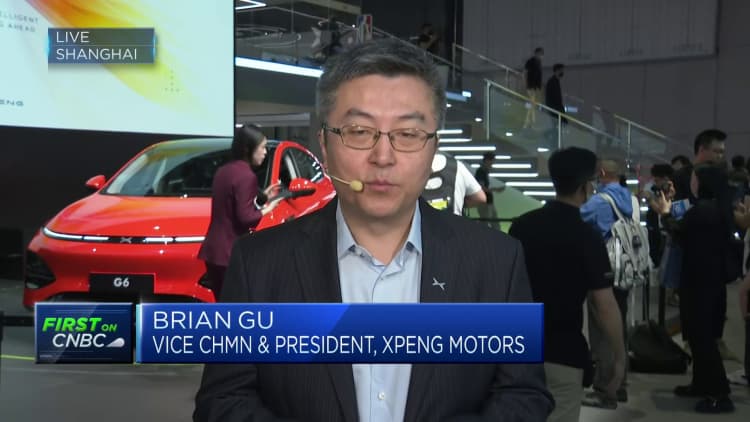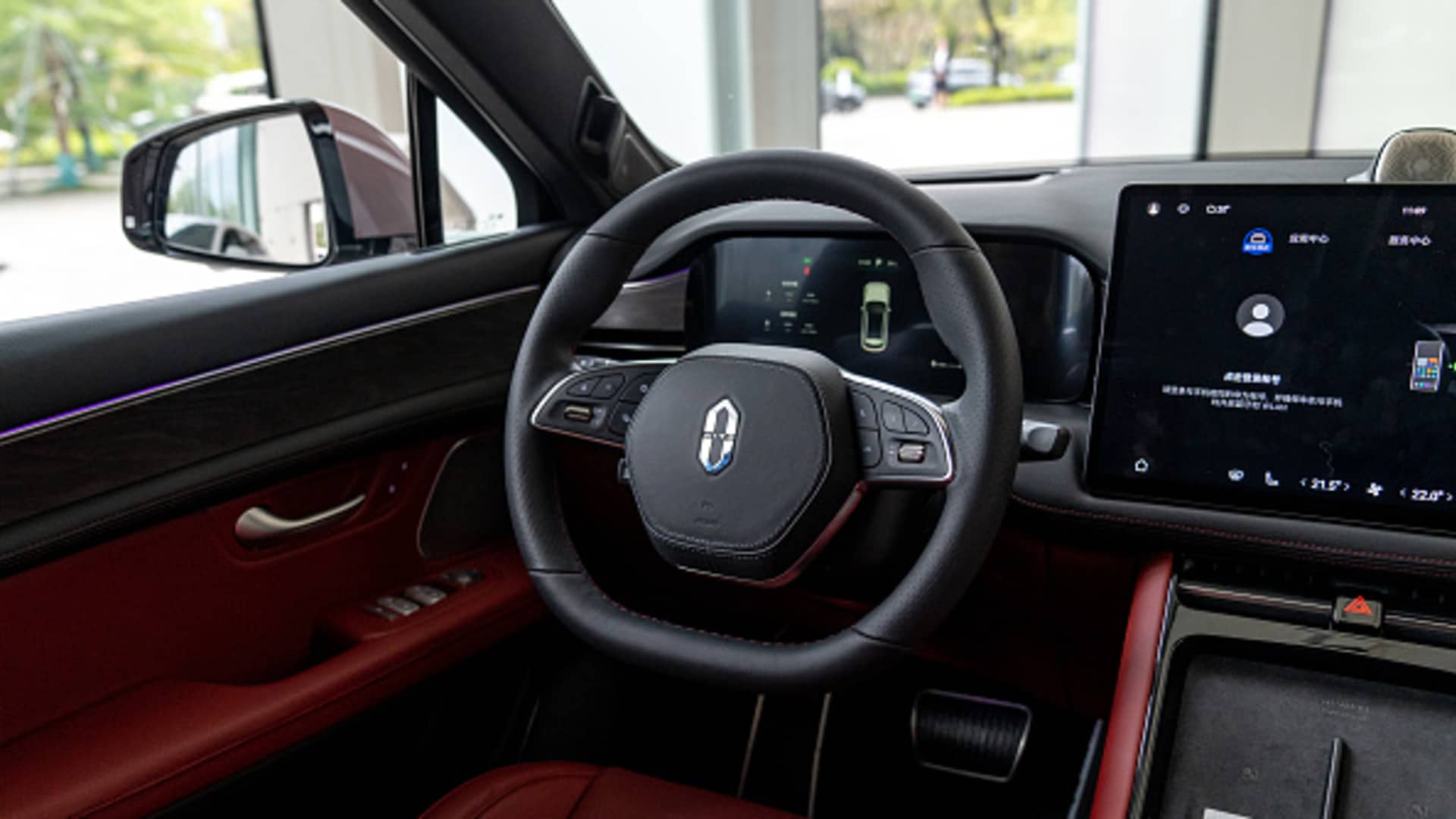Huawei’s co-developed Aito electric car brand is now selling an updated version of the M5 model that comes with new driver-assist tech.
Bloomberg | Bloomberg | Getty Images
BEIJING — Companies in China are playing up assisted driving technology as a way to compete in the hot electric car market.
Around the Shanghai auto show that kicked off last week, electric car startups and Chinese tech companies alike made several announcements about their driver-assist tech.
It’s not clear how powerful any of the announced features are — and whether Chinese consumers want to buy them. Current regulation also limits how much companies can allow tech to control driving.
But McKinsey estimates assisted and fully autonomous driving systems in passenger cars could generate $300 billion to $400 billion in global revenue by 2035. China is the world’s largest car market.
Among the recent announcements, Huawei said it would upgrade its driver assistance system for changing lanes on highways and parking — and expand support for city driving. The company said its new product, called “Huawei ADS 2.0” costs 36,000 yuan ($5,218) on a one-time basis or 7,200 yuan annually.
The tech is slated for initial release on an upgraded Aito M5 — set to begin deliveries in June — with future rollout to the Avatr 11 and Arcfox Alpha S. All three electric vehicles come from brands that already incorporate Huawei’s technology.

Li Auto announced plans to roll out driver-assist tech to customers in 100 cities in China by the end of the year — a feature the company claimed would be “free for life.” That’s according to a CNBC translation of the Chinese.
Those and other announcements follow Xpeng’s rollout in the last few weeks of driver-assist technology to some users Shanghai. The tech claims to require drivers to do little more than keeping their hands on the wheel, while the vehicle travels to a destination in the city on its own, including stopping at traffic lights. Xpeng’s tech was previously only available in Shenzhen and Guangzhou.
Such urban scenarios are becoming an area of differentiation in China.
We recognize that, as a startup, the only path to possibly achieving autonomous driving is to follow Tesla’s path.
Maxwell Zhou
DeepRoute.ai, CEO
Tesla doesn’t offer its driver-assist tech in Chinese cities — a feature marketed overseas as “Full Self Driving.” Only the company’s Autopilot for assisting with driving on highways is available in China.
“If you don’t offer [assisted driving tech] by next year then it’s going to be really impossible to compete,” Maxwell Zhou, CEO of autonomous driving software startup DeepRoute.ai, told a few reporters last week in Mandarin. That’s according to a CNBC translation.
The company’s latest driver-assist software — used together with cameras and other hardware — is set to reach consumers this year, through passenger cars from “an established automotive brand,” the four-year-old startup announced in late March, without sharing a name.
The maps debate
One of DeepRoute’s selling points is doing away with “high-definition maps.” That allows a vehicle to use driver assist tech on roads where those technical parameters haven’t been created.
It’s a trend car brands such as Xpeng and Huawei are pursuing — and Tesla’s strategy for developing autonomous driving.
Elon Musk’s car company has focused on using cameras and artificial intelligence to steer the vehicle, without heavy reliance on HD maps.
Those maps, used by autonomous driving companies such as Alphabet‘s Waymo, give a car a detailed picture of city streets. But they need to be created before a car runs on the road.
That process can drive up costs. DeepRoute’s Zhou estimated each car for gathering data would require $100,000, and an additional $30,000 a year to operate — for a total of about $2 billion or $3 billion, not including the cost of human labor.
“We recognize that, as a startup, the only path to possibly achieving autonomous driving is to follow Tesla’s path,” Zhou said.
“Because as a startup, there’s no way we could spend several billions of U.S. dollars just to buy cars, buy data. Waymo can do that,” he said. Zhou added that since China keeps fixing its roads, it would be difficult to constantly supply cars with accurate enough maps.
Too advanced for consumers?
Despite overall growth in new energy vehicle sales, it remains unclear whether Chinese consumers care enough about driver-assist tech when most of them haven’t used it yet. The market this year has focused on price cuts to attract buyers.
Xpeng, considered one of the most advanced technologically, saw deliveries plunge in the first quarter ahead of a more widespread rollout of its assisted driving tech. Industry giant BYD has downplayed self-driving tech.
Nio CEO William Li told CNBC that driver-assist technology ranks relatively low among users’ needs. But he said that people tend to rely on it once they try it — which will help drive relatively fast adoption.
Still, DeepRoute’s Zhou noted the discussion in China is currently dominated by car companies and trade publications, not consumers.
Most cars with advanced driver-assist tech only operate on highways, while the few that can run on city streets are more expensive, said Zhang Xin, executive editor-in-chief of AutoR, an industry publication with more than 110,000 followers on the Twitter-like Weibo platform.
Consumers who simply buy the most advanced technology may find they don’t end up using it, he said. Zhang added that map-free driver-assist systems are not yet powerful enough to completely do away with maps.
Money in components
Part of car companies’ wider interest in driver-assist tech comes from lower costs.
Shanghai-based Hesai makes the light detection and ranging (LiDAR) units often used for driver-assist systems. CEO David Li said just a few years ago, those units were priced around $10,000, making them “virtually impossible to be used for passenger cars.”
Now lidar units cost a couple hundred dollars, he said, noting expectations for hundreds of thousands of lidar unit sales this year.
“We see great momentum this year already,” Li told CNBC last week.
Hesai shipped more than 40,000 lidar units in the fourth quarter, up from 87 in the year-ago period, according to the company. Quarterly net revenue grew by nearly 57% year-on-year to 409.2 million yuan, while loss from operations increased by 65% to 140.1 million yuan.
The company’s customers include Li Auto and manufacturers in the U.S. and Germany. This year, Hesai announced deals with Didi-backed autonomous truck company KargoBot and Seres, which manufactures cars for Huawei, among others.


